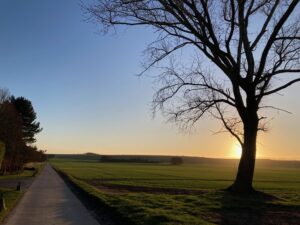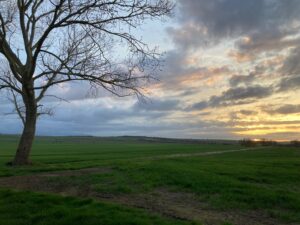
Here in the northern hemisphere we are welcoming the beginning of astronomical spring, as the earth tilts towards the sun. After this day of balance, where the length of the day and night is approximately equal, we head into the season of lengthening days and warmer weather. Such a gift to those of us who often struggle in winter.
For all the years that I’ve been marking these threshold dates of the seasons I’ve tended to focus on the equinoxes’ quality of balance, how things are held suspended between the two extreme poles of winter and summer. Something in that has always felt quite comforting to me; I am by nature a middle-way kind of person, finding the extremes of things difficult. It’s always a relief to be in this interstitial time, where I can feel the energy returning after the hibernation of winter, but I am not yet feeling overwhelmed by the high pitch of summer.
This year things have felt different. We have been living in the countryside for a little over a year now and being surrounded by the sky, having such easy access to the sun, moon and the stars, I have been paying greater attention to how these celestial bodies move and how that seems to affect me. When we lived in London it was hard to witness the exact moments of the sun rise and sun set, but now, weather and energy levels permitting, I can often see them. No longer is my relationship with the moon sporadic, her face hidden by buildings. Armed with an app on my phone and the vastness of the sky above, I can usually find her each day and delight in that connection. I am witnessing, incrementally, the passage of time when I observe that the sun is setting almost exactly west, behind some trees, now that we are at the equinox, compared to its more southerly descent, behind the Ridgeway, at the winter solstice. Soon enough the sun will be setting towards the north, behind the field with the path across it. When I notice this, I feel connected to the generations of our ancestors who knew this too and who organised their lives around this procession of the sun, who built monuments and gathering places to celebrate the darkness and the return of the light. People who knew they were of the earth, part of nature, not humans who had become adrift from this truth.

But this year something else about the equinox, that I have always known but never really thought about, suddenly felt like a revelation: at the equinox, because the earth is perpendicular to the sun and we are not yet tilted on its axis, the length of the day and the night being approximately equal happens ALL OVER the planet. Every single human will have the same experience of the light for these few short days. We are united in this moment. And I find that deeply moving. In societies that want us to be disconnected from the experiences of others, that wants to assert a hierarchy on who deserves to have our attention, who deserves to live in freedom, who deserves to live at all, the fact is – we are all humans living on the same planet, with the same experiences of the sun, the moon and the stars, we all look up in wonder, we all look around and search for love, connection, belonging.
For the past 6 months I have been in deep grief and rage about the state of the world, witnessing genocides in Palestine, Congo and Sudan on my phone, taking action where I can (being a pain in the arse to my MP, boycotting, donating, marching with thousands of siblings who stand for humanity). It all feels woefully inadequate, still it must be done. But what I am taking comfort in, when the despair sets in, as it regularly does, is the interconnected nature of humanity and how similar we all are, how there is no difference between the kids I see around me here, and the kids I see everywhere else. How beautiful to be reminded of that sameness on this day of equal light and equal dark. And as we head into the season of light and growth I have to hope with everything I’ve got that we mobilise towards the better world we all deserve.
[A couple of fantastic books on this theme of belonging, connection, revolutionary love are:
You Belong by Sebene Selassie and See No Stranger by Valarie Kaur]